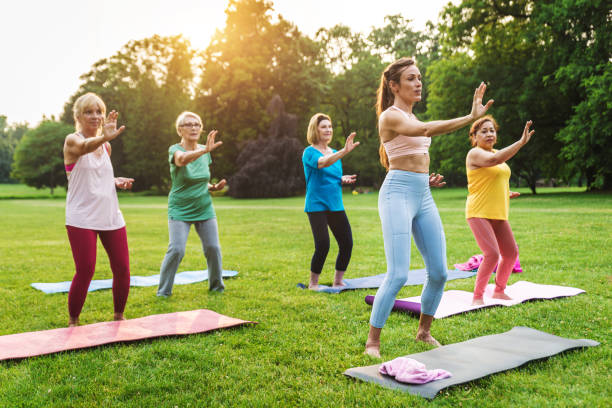The Top 5 Exercise Modalities for Managing Fibromyalgia Pain
As you age, your body is constantly changing and adapting to different circumstances in life.
Unfortunately, one of the most challenging changes you can experience is the onset of fibromyalgia.
The Centers for Disease Control reports that over 4 million adults in the U.S. battle fibromyalgia. Worse yet, it is more common in women compared to men (77.7% in women and 4.9% in men).
As a chronic condition, fibromyalgia can cause widespread pain, fatigue, and other symptoms that can greatly impact our quality of life.
While the causes of fibromyalgia stay unknown, there are ways to manage fibromyalgia pain, and one of the most effective methods is through exercise.
In this guide, we have compiled a list of simple yet effective exercises to help you ward off fibromyalgia and manage fibromyalgia pain.
But what is it like to live with fibromyalgia?

The Challenges of Fibromyalgia
Fibromyalgia is a chronic pain condition that affects millions of people worldwide. It is a debilitating illness that can severely impact one’s quality of life. Although fibromyalgia can affect anyone, it is more common in women than men, and it tends to develop in middle age.
Below are the key challenges of fibromyalgia:
Unpredictability of Symptoms
The pain and fatigue can come and go, making it difficult to plan activities or engage in daily tasks. Many people with fibromyalgia also report difficulty sleeping, which can exacerbate symptoms and make it harder to manage pain.
Lack of Understanding and Awareness of the Condition
Because fibromyalgia is an invisible illness, meaning that there are no visible signs of the condition, it can be challenging for others to understand the severity of the symptoms. This lack of understanding can lead to feelings of isolation and frustration for people living with fibromyalgia.
Financial Implications
Many people with fibromyalgia require ongoing medical care, including medications, physical therapy, and other treatments, which can be costly. The condition may also make it difficult to work, leading to lost income and financial strain.
Despite these challenges, there are ways to manage fibromyalgia and improve one’s quality of life. One of the most important steps is to engage in proven-to-work exercises.
So how can exercise help you prevent and manage fibromyalgia pain?

Incorporating Exercise into Fibromyalgia Management: Key Approaches from Specialists
When it comes to managing fibromyalgia pain, certain exercise modalities are more effective than others. Here are some of the best types of exercise for women seeking to avoid fibromyalgia or manage fibromyalgia pain:
1. Restorative Yoga
Restorative yoga is a type of yoga that focuses on relaxation and stress relief. It is a gentle form of yoga that uses props like blankets, blocks, and bolsters to support the body in various poses. Restorative yoga is designed to help the body relax and release tension, which can be especially helpful for people with fibromyalgia.
One of the benefits of restorative yoga for fibromyalgia is that it can help reduce pain and stiffness in the muscles and joints. The gentle stretching and relaxation techniques used in restorative yoga can help increase blood flow and oxygen to the muscles, which can help reduce inflammation and pain.
Another benefit of restorative yoga for fibromyalgia is that it can help improve sleep. Many people with fibromyalgia struggle with sleep, and restorative yoga can be a helpful tool for promoting relaxation and improving sleep quality. The gentle poses and deep breathing techniques used in restorative yoga can help calm the mind and promote restful sleep.
Restorative yoga can also help manage stress and anxiety, which are common symptoms of fibromyalgia. The relaxation techniques used in restorative yoga can help reduce stress and promote feelings of calm and well-being. Regular practice of restorative yoga can help improve overall mental health and well-being, which can be especially beneficial for people with fibromyalgia.
When practicing restorative yoga for fibromyalgia, it is important to work with a qualified yoga instructor who has experience working with people with chronic pain conditions. A good instructor can help you modify the poses to suit your individual needs and avoid any movements that may exacerbate your symptoms.

2. Tai Chi
Tai chi is an ancient Chinese practice that combines slow, gentle movements with deep breathing and meditation. It has been practiced for centuries in China and is now popular worldwide as a form of exercise and relaxation. Tai chi is a low-impact exercise that can be done by people of all ages and fitness levels.
Tai chi can help reduce stress and anxiety, which are often triggers for fibromyalgia symptoms. By practicing tai chi regularly, you can learn to relax your body and mind, which can help reduce pain and improve your overall sense of well-being.
Another way that Tai Chi can help manage fibromyalgia pain is by improving flexibility and balance. Many people with fibromyalgia experience stiffness and joint pain, which can make it difficult to perform everyday tasks. Tai chi can help stretch and strengthen the muscles, which can improve flexibility and reduce pain.
In addition to its physical benefits, Tai Chi can also help improve sleep quality, which is essential for people with fibromyalgia. Many people with fibromyalgia struggle with sleep disturbances, which can exacerbate their symptoms. Tai chi can help promote relaxation and improve sleep quality, which can help reduce pain and improve overall health.

3. Light Strength Training
Light strength training involves performing exercises with low weight loads and a high number of repetitions. This type of exercise is effective in reducing pain and improving physical function in people with fibromyalgia. Additionally, light strength training can help prevent the onset of fibromyalgia in people who are at risk.
The benefits of light strength training for fibromyalgia are numerous. First, it can help improve muscle strength and endurance, which can help reduce pain and fatigue. Additionally, it can help increase flexibility and range of motion, which can help improve joint function and reduce stiffness. Lastly, light strength training can help improve mood and reduce stress, both of which are important factors in managing fibromyalgia symptoms.
To get started with light strength training, work with a qualified fitness professional who can help design a program that is tailored to your needs and abilities. Your program should include exercises that target all major muscle groups, including the arms, legs, chest, back, and core. Additionally, your program should include a warm-up and cool-down period to help prevent injury and reduce muscle soreness.
When performing light strength training exercises, remember to use proper form and technique. This means using a weight load that is appropriate for your current level of fitness and performing each exercise slowly and with control. Additionally, it’s important to take breaks as needed and to listen to your body. If you experience pain or discomfort during an exercise, stop immediately and consult with your fitness professional.

4. Low-Impact Aerobics
Low-impact aerobics are exercises you can do without putting too much strain on the joints. These exercises can help to improve blood flow, reduce inflammation, and increase flexibility, all of which can help to alleviate the pain associated with fibromyalgia.
Among the best low-impact aerobics exercises for fibromyalgia is swimming. Swimming is a great way to exercise because it is low-impact and puts very little strain on the joints. Additionally, swimming is an excellent cardiovascular workout, which can help to boost your overall health and well-being.
Another great low-impact aerobics exercise for fibromyalgia is walking. Walking is an easy way to get your heart rate up and improve your overall fitness level. Additionally, walking can be done almost anywhere, so it is a great option for those who may not have access to a gym or pool.
When starting a low-impact aerobics program for fibromyalgia, it is essential to start slowly and gradually increase the intensity of your workouts. It is also important to listen to your body and not push yourself too hard. If you experience pain or discomfort during your workouts, it is essential to stop and rest.

5. Water Aerobics
Water aerobics is a low-impact exercise that takes place in a pool. The buoyancy of the water reduces the stress on your joints and allows you to move freely without causing pain. It is an excellent way to get your heart rate up and increase your endurance without putting too much strain on your body.
If you have fibromyalgia, water aerobics can be a great way to manage your pain. Here are some tips on how to get started:
1. Talk to Your Doctor
Before starting any new exercise program, it’s important to talk to your doctor. They can help you determine if water aerobics is right for you and provide any specific guidelines you should follow.
2. Find a Pool
Find a pool near you that offers water aerobics classes. Many gyms and community centers offer these classes, and they are often low-cost or even free.
3. Start Slow
If you’re new to exercise or haven’t been active in a while, it’s essential to start slow. Take it easy and listen to your body. If you experience any pain or discomfort, stop immediately.
4. Use Flotation Devices
Using flotation devices like pool noodles or kickboards can help support your body and reduce the strain on your joints. They can also help you maintain proper form while exercising.
5. Stretch Before and After
Stretching is important before and after any exercise. It helps warm up your muscles and prevent injury. Be sure to stretch before and after your water aerobics class.
6. Stay Hydrated
It’s essential to stay hydrated while exercising, especially in the water. Drink plenty of water before, during, and after your workout.
7. Listen to Your Body
The most important thing to remember is to listen to your body. If you’re experiencing pain or discomfort, stop immediately. Don’t push yourself too hard, and take breaks as needed.
Water aerobics can be an effective way to manage the pain associated with fibromyalgia. It’s a low-impact exercise that can help improve your endurance and overall health. If you’re interested in trying water aerobics, talk to your doctor and find a class near you. Remember to start slow, use flotation devices, stretch, stay hydrated, and listen to your body. With time and practice, you can use water aerobics to help manage your fibromyalgia pain.
When starting an exercise program to manage fibromyalgia pain, it’s important to start slowly and listen to your body. Begin with just a few minutes of exercise each day and gradually increase the duration and intensity as your body allows. Advisably, stay hydrated and fuel your body with nutrient-dense foods to support your exercise routine.

The Bottom Line
Exercise is a powerful tool for managing fibromyalgia pain.
By incorporating restorative yoga, Tai Chi, light strength training, low impact aerobics, and water aerobics into your routine, you can reduce pain, improve mobility, and enhance your overall quality of life.
Remember to start slowly, listen to your body, and stay consistent with your exercise routine to reap the full benefits.
Looking to stay healthy without breaking the bank? Don’t look any further.
Subscribe to Kloud Iron’s 28-day fitness program and begin your journey toward optimal mental health and physical fitness.
To learn more about Kloud Iron Fitness Hub’s offers, contact us today or message/follow us on Facebook and Instagram. We are also available on YouTube.


Leave Your Comment